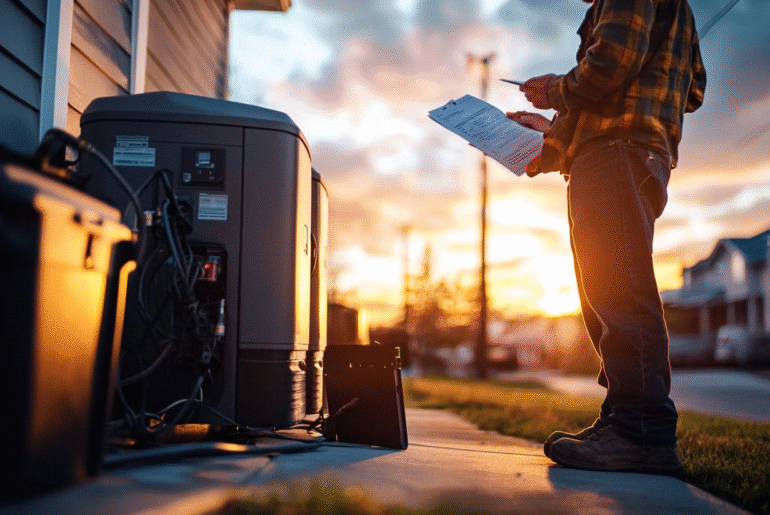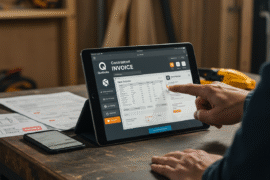This article may contain references to products or services from one or more of our advertisers or partners. We may receive compensation when you click on links to those products or services. Nonetheless, our opinions are our own.
The information presented in this article is accurate to the best of our knowledge at the time of publication. However, information is subject to change, and no guarantees are made about the continued accuracy or completeness of this content after its publication date.
Key Highlights
- Backup generators provide reliable power during blackouts, ensuring that essential appliances remain operational.
- The costs for installation can vary, with whole-home generator setups averaging between $20,000 and $25,000.
- Portable generators offer a more affordable option, ranging from $400 to $1,000, but have limited power.
- The cost of generators depends on factors such as size, type, fuel, labor, and additional features.
- Standby generators can increase your home’s value and offer peace of mind, especially in areas prone to frequent blackouts.
Routine maintenance is critical for guaranteeing the longevity of generators, with proper care extending their lifespan to 15–20 years.
Let’s explore the basics of backup generators, which provide a reliable solution when the power goes out.
Introduction
Power outages, particularly during storms or heatwaves, can disrupt daily life by affecting heating and cooling systems, as well as appliances. Backup generators, particularly standby models, offer an efficient and immediate solution. They help maintain the functionality of homes during power disruptions, providing comfort and safety.
Financing options, such as traditional loans, may be available to help cover the initial investment. However, it’s important to carefully consider the installation costs and long-term benefits before purchasing. This guide explains why investing in a backup generator could be a worthwhile decision.
Understanding Backup Generators
Backup generators are becoming increasingly popular due to the rise in power outages caused by extreme weather events and overburdened power grids. Many models include useful features, such as automatic transfer switches, which activate the generator as soon as the power goes out.
Generators vary in size, price, and functionality, ranging from small portable models to large systems capable of powering an entire home. Understanding these different types can help homeowners make informed decisions about improving their home’s energy resilience.
What is a Backup Generator?
A backup generator provides electricity when the main power supply fails. It detects the outage and automatically activates through a transfer switch. The process ensures that essential devices, such as sump pumps and refrigerators, continue to operate.
Standby generators are directly linked to the home’s electrical system and offer seamless operation. These units run on fuels like natural gas, propane, or diesel, converting mechanical energy into electricity, which is vital in areas with frequent power outages.
Different Types of Backup Generators
Backup generators vary in cost, size, and energy source. Each type serves different needs:
- Portable generators: Prices range from $400 to $1,000. These generators provide short-term power and require manual operation and frequent refueling.
- Whole-home generators: Costing between $18,000 and $28,000, these systems can power an entire house and operate automatically.
- Solar-powered generators: Environmentally friendly but reliant on sunlight, these models range from $2,000 to $25,000.
Choosing the right generator depends on factors such as fuel availability, power requirements, and ease of use.
Assessing Your Needs
The decision to purchase a backup generator should begin by evaluating how much energy your home requires and understanding the risks of power loss. Outages can lead to severe consequences, such as frozen pipes or the failure of essential medical equipment.
Consider your home’s size, energy usage, and available fuel sources. It is crucial to select the appropriate type of generator. Whether you choose a portable or whole-home system, ensure that its capacity meets your energy needs, guaranteeing reliable backup power.
Voted "Best Overall Budgeting App" by Forbes and WSJ
Monarch Money helps you budget, track spending, set goals, and plan your financial future—all in one app.
Get 50% OFF your first year with code MONARCHVIP
Determining the Right Size and Power for Your Home
Choosing the right generator requires calculating your home’s energy demand in kilowatts (kW). A smaller generator may only be sufficient for powering essential appliances like refrigerators. In contrast, larger generators can power an entire household.
For example, a small home might require around 7 kW, while larger homes may need between 26 and 32 kW. To avoid underpowered systems and avoid unnecessary expenses, perform a load calculation or consult a professional.
Key Considerations Before Purchase
Several factors should be carefully considered to ensure the generator’s value and long-term functionality:
| Factor | Details |
|---|---|
| Cost Difference | Portable generators ($400–$1,000) vs. whole-home systems ($18,000–$28,000) |
| Type of Fuel | Natural gas, propane, gasoline, or solar energy |
| Installation Costs | Labor, permits, and concrete pad construction may add to the total cost |
Consider well-known brands, warranties, and ongoing maintenance requirements. Consulting licensed professionals is essential to understand the installation process, including potential permits and system modifications.
Knowledgeable purchasing prevents surprises and ensures the generator functions effectively for many years.
Step-by-Step Guide to Getting a Backup Generator
Installing a backup generator involves several steps. Here is a simplified overview:
Step 1: Evaluate Your Power Needs
Start by identifying which appliances you want to keep running during a power outage. Add up their total wattage, then assess your daily energy usage.
Fuel type is also important. Smaller generators use less fuel but may not supply enough power for all your needs. Understanding your home’s power requirements helps you select the right generator size and fuel storage needs.
Step 2: Choose the Type of Generator
Choose a generator based on your preferred fuel source, budget, and ease of use. If your home has access to natural gas lines, the generator could be a convenient and affordable option. Propane tanks are another option, though they may come with higher installation costs.
Decide if you need an automatic transfer switch to power the generator during an outage. Portable generators are versatile but require manual operation, while solar-powered options are environmentally friendly but depend on sunlight.
Step 3: Installation Process
Proper installation involves electrical wiring, utility connections, and adherence to local safety codes. Typically, generators are set up on a concrete pad near the house.
Hiring professionals ensures that installation complies with building codes, especially when adding automatic switches or modifying electrical panels. Once installed, test the system during a real power outage to ensure it functions as expected.
Professional installation guarantees safety, efficiency, and long-term reliability.
Conclusion
Investing in a backup generator offers security and convenience during power outages. It allows your home to remain operational, protects vital systems, and can even increase property value.
Carefully assessing your power needs, considering different generator types, and preparing for installation are crucial steps in making an informed decision. Although the initial costs may seem high, the long-term benefits—especially in areas prone to frequent power outages—make backup generators a valuable investment. Consult a licensed expert to explore your options and choose the generator that best suits your home.
Frequently Asked Questions
How much does a backup generator cost?
Prices vary depending on size, type, and installation. Portable generators start at around $400, while whole-home systems typically cost between $18,000 and $25,000. Installation and ongoing maintenance should also be considered in the total cost. Some insurance plans offer discounts for homes with backup generators.
Are backup generators worth the investment?
Yes, backup generators prevent the disruption caused by power outages, ensure the continued operation of critical systems, and provide peace of mind. They can also increase your home’s value and may lead to savings on insurance premiums. Consult an expert to determine if this investment aligns with your long-term goals.
What maintenance is required for a backup generator?
Regular maintenance, including oil changes and professional servicing, is essential. Following the manufacturer’s guidelines will help maintain warranty coverage and ensure the generator operates smoothly for years. While maintenance expenses may vary, routine care extends the lifespan and reliability of the unit.
Can a backup generator increase property value?
A backup generator can enhance a home’s value, particularly in regions with unreliable power supply. It adds security and appeal to potential buyers, especially those searching for homes equipped with reliable power sources.

Reviewed and edited by Albert Fang.
See a typo or want to suggest an edit/revision to the content? Use the contact us form to provide feedback.
At FangWallet, we value editorial integrity and open collaboration in curating quality content for readers to enjoy. Much appreciated for the assist.
Did you like our article and find it insightful? We encourage sharing the article link with family and friends to benefit as well - better yet, sharing on social media. Thank you for the support! 🍉
Article Title: How Much Does a Backup Generator Cost and Is It Worth the Investment?
https://fangwallet.com/2025/05/15/backup-generator-cost/The FangWallet Promise
FangWallet is an editorially independent resource - founded on breaking down challenging financial concepts for anyone to understand since 2014. While we adhere to editorial integrity, note that this post may contain references to products from our partners.
The FangWallet promise is always to have your best interest in mind and be transparent and honest about the financial picture.
Become an Insider

Subscribe to get a free daily budget planner printable to help get your money on track!
Make passive money the right way. No spam.
Editorial Disclaimer: The editorial content on this page is not provided by any of the companies mentioned. The opinions expressed here are the author's alone.
The content of this website is for informational purposes only and does not represent investment advice, or an offer or solicitation to buy or sell any security, investment, or product. Investors are encouraged to do their own due diligence, and, if necessary, consult professional advising before making any investment decisions. Investing involves a high degree of risk, and financial losses may occur including the potential loss of principal.
Source Citation References:
+ Inspo
There are no additional citations or references to note for this article at this time.












































